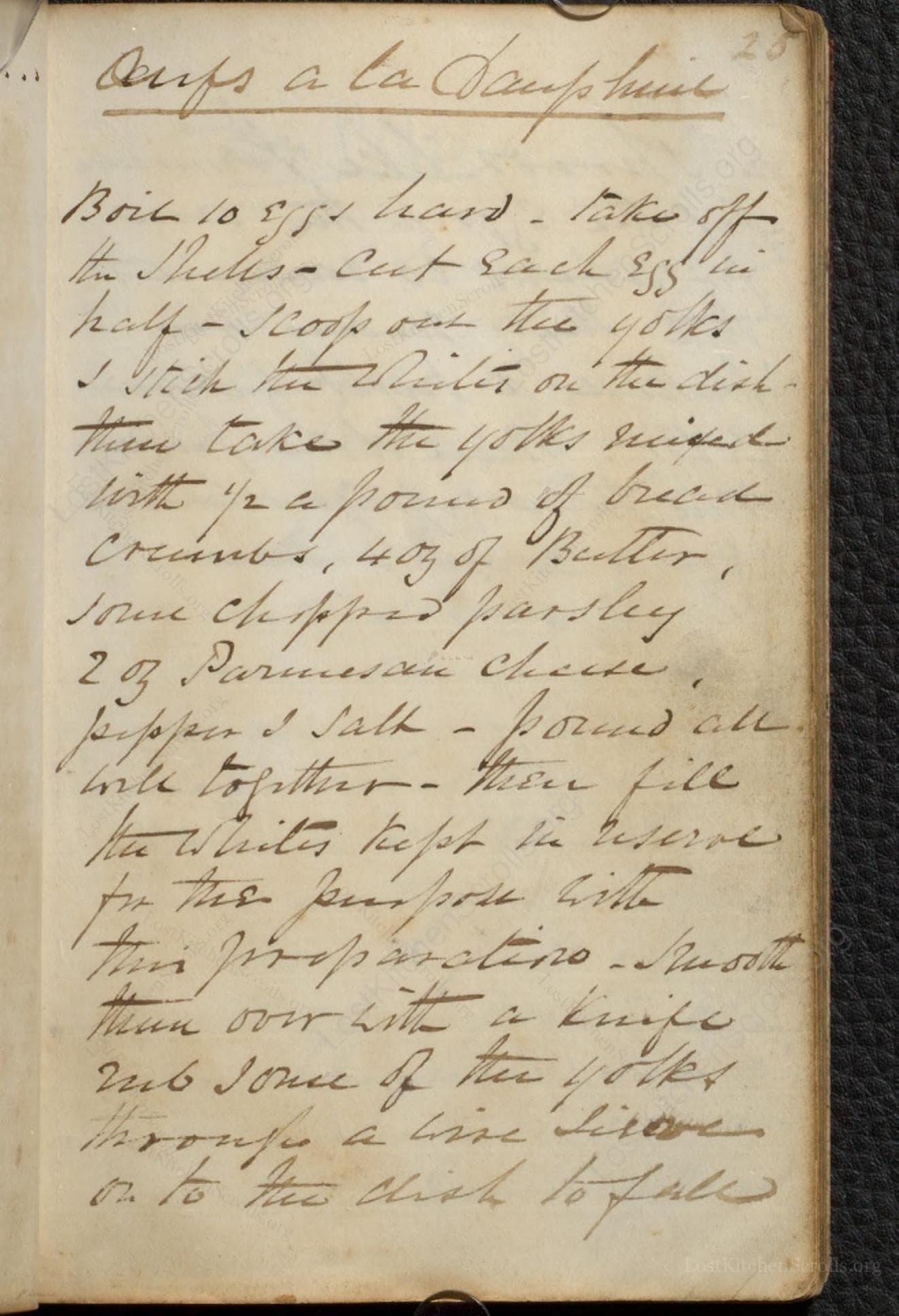Oeufs A La Dauphine
From the treasured pages of Recipe book of Charles Ellice, Colonel, 24th Regiment
Written by Charles Ellice, Colonel

Oeufs A La Dauphine
"Boil 10 Eggs hard - take off the Shells - Cut each Egg in half - Scoop out the yolks & Stick the Whites on the dish. then take the yolks mixed with 1/2 a pound of bread crumbs, 4 oz of Butter, some Chopped Parsley, 2 oz Parmesan Cheese, pepper & salt - pound all well together - then fill the Whites kept in reserve for the purpose with this preparation - Smooth them over with a knife Rub some of the yolks through a fine sieve on to the dish to bake"
Note on the Original Text
The recipe is written in concise, practical language typical of mid-19th-century manuscript cookbooks. Directions are abrupt, lacking specific weights, oven temperatures, or timings—assumptions were made about the cook’s experience and intuition. Spelling and phrasing occasionally lean toward the period’s vernacular ('Boil 10 Eggs hard', 'Stick the Whites on the dish'), and key steps are described sequentially without detailed explanation. Measurements such as '1/2 pound' or '4 oz' reflect the Imperial system in use; modern equivalents make the recipe accessible to contemporary cooks.

Title
Recipe book of Charles Ellice, Colonel, 24th Regiment (1856)
You can also click the book image above to peruse the original tome
Writer
Charles Ellice, Colonel
Era
1856
Publisher
Colonel Charles Ellice
Background
A charming manuscript cookbook chronicling the culinary escapades of Colonel Charles Ellice during his globe-trotting military career, featuring recipes from Highland butter to yeastless bread, spicy curries, and even a dash of Victorian medicine—all penned alongside evocative ink sketches and a personal index.
Kindly made available by
McGill University
This charming recipe hails from the personal recipe collection of Colonel Charles Henry Ellice, a British officer whose tours of duty took him from Scotland’s Highlands to colonial India during the 19th century. His handwritten cookbook, begun in 1856, is a snapshot of the culinary cross-pollination and improvisation found among British military officers far from home. Recipes wander from homely breads to Indian curries, echoing the diverse influences of Ellice’s postings. 'Oeufs a la Dauphine' is a nod to French cuisine adapted for the British table. The method reflects a love for reimagining simple ingredients—hard-boiled eggs and breadcrumbs—into elegant, comforting fare. Dishes like this reveal not only what people ate, but how they preserved a sense of familiarity and luxury amidst the rigors of empire and travel.

In the 19th century, these eggs would have been boiled in a heavy saucepan over an open fire or a hob. A small, sharp knife and a spoon would assist in removing yolks and filling the eggs. The mixing was likely done with a wooden or metal spoon, or the ingredients could be pounded together in a stone or marble mortar and pestle for a fine texture. The final stage—baking—would have taken place in a cast-iron range or a small baking oven, using a heavy metal or earthenware dish. A fine sieve would be used for sifting yolks or breadcrumbs for that finishing golden dusting.
Prep Time
15 mins
Cook Time
20 mins
Servings
10
We've done our best to adapt this historical recipe for modern kitchens, but some details may still need refinement. We warmly welcome feedback from fellow cooks and culinary historians — your insights support the entire community!
Ingredients
- 10 large eggs
- 8 oz fresh breadcrumbs (or 8 oz stale bread, finely grated or pulsed in a food processor)
- 4 oz unsalted butter (softened)
- 2 tablespoons fresh parsley, finely chopped
- 2 oz Parmesan cheese, finely grated
- Salt, to taste
- Black pepper, to taste
Instructions
- Begin by boiling 10 large eggs until hard-boiled, about 10 minutes.
- Once cool enough to handle, carefully peel off the shells.
- Slice each egg in half lengthwise, then gently scoop out the yolks and set aside.
- Arrange the egg whites, cup side up, on a baking dish.
- For the filling, mash the reserved yolks in a bowl and mix with 8 oz fresh breadcrumbs, 4 oz unsalted butter (softened), 2 tablespoons of finely chopped fresh parsley, 2 oz grated Parmesan cheese, and salt and pepper to taste.
- Blend or pound this mixture until smooth and well-combined.
- Fill each egg white half generously with the yolk-breadcrumb mixture, smoothing the tops with a knife.
- Sprinkle extra sieved hard-boiled egg yolk or golden breadcrumbs over the filled eggs.
- Bake in a preheated oven at 350°F for about 10–15 minutes, until lightly golden and heated through.
- Serve warm.
Estimated Calories
120 per serving
Cooking Estimates
It will take you about 15 minutes to prepare the ingredients and eggs. Boiling the eggs takes 10 minutes, and baking takes another 10-15 minutes. Each filled half has about 120 calories. This recipe makes 20 stuffed egg halves, which is 10 servings if you serve 2 halves per person.
As noted above, we have made our best effort to translate and adapt this historical recipe for modern kitchens, taking into account ingredients nowadays, cooking techniques, measurements, and so on. However, historical recipes often contain assumptions that require interpretation.
We'd love for anyone to help improve these adaptations. Community contributions are highly welcome. If you have suggestions, corrections, or cooking tips based on your experience with this recipe, please share them below.
Join the Discussion
Rate This Recipe

Den Bockfisch In Einer Fleisch Suppen Zu Kochen
This recipe hails from a German manuscript cookbook compiled in 1696, a time whe...

Die Grieß Nudlen Zumachen
This recipe comes from a rather mysterious manuscript cookbook, penned anonymous...

Ein Boudain
This recipe comes from an anonymous German-language manuscript cookbook from 169...

Ein Gesaltzen Citroni
This recipe, dating from 1696, comes from an extensive anonymous German cookbook...
Browse our complete collection of time-honored recipes



